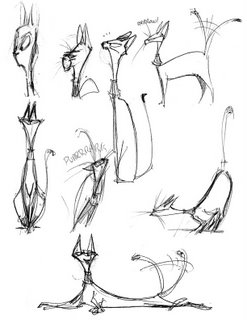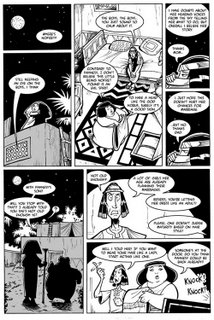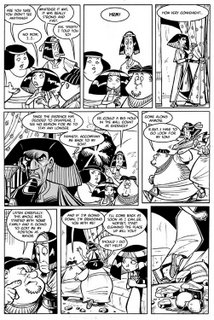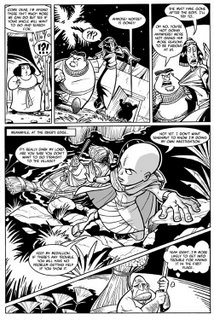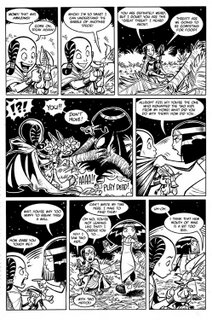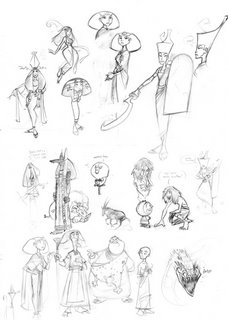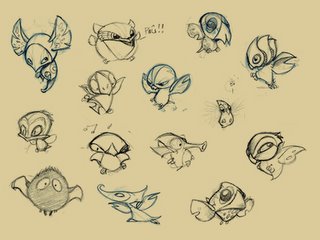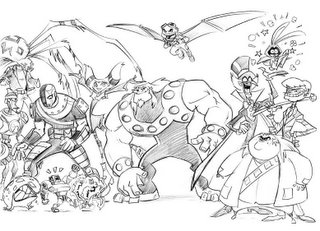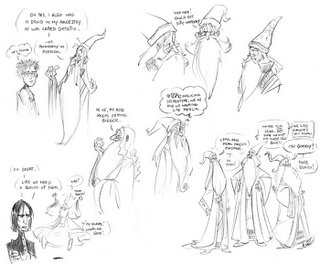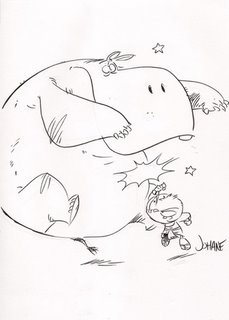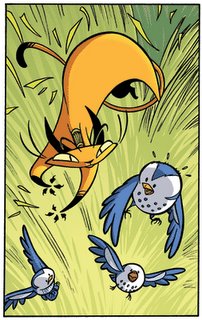JOHANE MATTE INTERVIEW
CHARACTER DESIGNER FOR COMICS AND GAMES
Thursday, December 01, 2005
BROUGHT TO YOU BY THE CHARACTER DESIGN BLOGSPOT
IF YOU WOULD LIKE TO SEE MORE CHARACTER DESIGNERS GO TO THE HOME PAGE BY CLICKING HERE
THE INTERVIEW
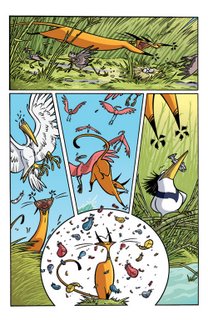
Tell me a little bit about yourself, about your life? Where did you go to school, and what classes did you study? What helped prepare you to become the artist that you are today?
I grew up in a quiet down in the northwest region of the province of Quebec in Canada. I remember exactly when I started to draw: my cousin had sent me a drawing
she had done, and I got soooooo jealous of her talent I decided that I'd try and do better. I was about 8-9 years old. Yup, jealousy started it all ;) It then grew into a passion. I remember trying to copy a lot from books and what I was seeing on television, and doodling incessantly in class. I believe I still have lots of little comic strips done in the fourth grade.
Jump a few years as I was about to go to college and didn't know about any animation or comic book courses being given in Quebec, except at University level (didn't know about Sheridan). I went to Algonquin College in Graphic Design. At least I would get to draw a bit. During that first year, the college announced they would start an animation course and I promptly jumped
ship the next year. We got to learn the basics, but this was the first time the course was given and it was still a bit lacking here and there. I learnt a whole lot more over the years, working in different studios with very talented colleagues.
How do you go about designing a character, and what goes through your mind, from start to end?
It depends: if it's a character that I have to create based on a script written by someone else, within an already preestablished design, I'll work differently than if it is my own project. I'll have to pay attention to any description the writer may have put, and try to add some of my own touches. I also have to triple check if what I've drawn doesn't clash with the look of the other characters. If it is done for animation, or if I know other people or going to try and draw the character, I try to put as much details on the construction of the characters as I can to help...production time allowing, of course. I don't put as much of my feelings and thoughts into these usually. It can be very restrictive but at the same time, a nice challenge. To try and draw something appealing, that will continue to be appealing and fun for the dozen of people that will get to play around with these designs.
If it's a character for my own projects, I get to go more wild and not worry so much about a production line. Sometime they'll be created out of a doodle, and then I'll start imagining stories about them, to build their personalities. I then play around with their shapes, their looks. I'll
sometimes hide the drawings for a few weeks, and get back to them. What I like and what I hate will usually jump out at me. I'll also try to exaggerate their proportions, play around with their styles, trying to see if I won't find something that clicks. It gets very intuitive and suggestive after a while. I also know that the more I'll draw the characters, they will keep evolving. Best to go with the flow then, and keep drawing...see where it will lead.
What do you think really helps you out in designing a character?
Observation! To notice people's quarks, be it physical or psychological. I always try and imagine their life stories (or part of their lives anyway), their personalities and their attitudes. It will influence a lot their poses and their shapes. Yup, I'm very big into creating personalities.
I always try to commit to memory designs and tricks from other artists for inspiration. How did someone else tackle a problem? How best to portray a loveable hero to a terrifying villain?
While drawing, I always try to take a few different directions and exaggerate to the point of the abstract or the caricature. It's not always easy, but details may emerge that can be used.
From your own experience and maybe from some people that you know, what should we put in our portfolio and what should we not?
You should mostly put your most recent material: the potential employer wants to see what you can do now, now what you could do 10 years ago (unless you are particularly proud of an old piece). Also, take only the drawings you are most proud of. If you find yourself having to defend any drawing weaknesses during an interview, that's a big no-no. Show versatility in your designs. Have a few color illustrations, and lots of character poses and expressions. I did mention versatility, and I think it would be important to also show other abilities like backgrounds drawings, comics or storyboards.
Don't be afraid to ask your friends to help you select what drawings look best. Feedback before sending your portfolio can be a learning experience by itself. Keep it nice, clean and keep your amount of pages to about 10-15.
What are you working on now? (If you can tell us)
I've just finished working on the Teen Titans video game. I've started on a new project, but since it hasn't been announced yet, I'm afraid I'll have to keep quiet about it. I'm also continuing my mini comic Horus on my own time, and planning some future stories for the Flight books.
Where is the place you would like to work if you had a choice?
Ooooh...I'd have to go for Pixar. I would also love to have the energy to go back to school and try getting into the Gobelin school in France. It would be also great to work in a small studio, near a talented artist that could be a mentor. Someone that could push me in other directions and help me refine my work.
Who do you think are the top character designers out there?
There are so many out there that I'm discovering almost daily now, thanks mostly to all the blogs popping here and there. I'm going to forget soooo many I just know it... but I have to mention Claire Wendling, Ben Caldwell, Steve Lambe, Justin Ridge, Peter DeSeve, Stephen Silver and Laurence Péguy. All big inspirations.
How do you go about coloring the character, what tools do you use?
In the old days, while working in animation, all the colorization was given to another department. I started doing a lot of coloring only about 5 years ago, and still have much to learn. I've been using Photoshop mostly, with the odd colored pencils here and there. I'm still very very clumsy with watercolors *blush*
What part of designing a character is most fun and easy, and what is most hard?
The most fun? Creating them from nothing, to give them a personality.
The most hard is to try and not repeat oneself or making it unique. There is so much influence around, I sometimes find myself drawing something too similar to an already existing character. I then have to go back and try and change it, not always to my satisfaction. In studio work, if I created a character I really liked or cared about, I need to be able to detach myself from it, knowing I'll never be able to use it for my own ideas. It can be hard.
What type of tools or media do you use?
Paper, pens and pencils, markers, trusty Faber Castell Pitt Pen and other pen brushes, and the computer.
What wisdom could you give us, about being a character designer?
Keep an open mind, be versatile. Be ready to get criticized (don't take it too personal). Always always draw and have fun doing it. Find time to create for yourself. For the dreadful blank page attack, just doodle around for a few minutes to warm up. And get some sleep once in a while.
IF YOU WOULD LIKE TO KNOW MORE ABOUT JOHANE MATTE GO TO http://drawingboard.org/blogs/Nofret/
Subscribe to:
Comments (Atom)

